power steering Lexus IS250C 2010 Owner's Manual
[x] Cancel search | Manufacturer: LEXUS, Model Year: 2010, Model line: IS250C, Model: Lexus IS250C 2010Pages: 586, PDF Size: 31.62 MB
Page 3 of 586
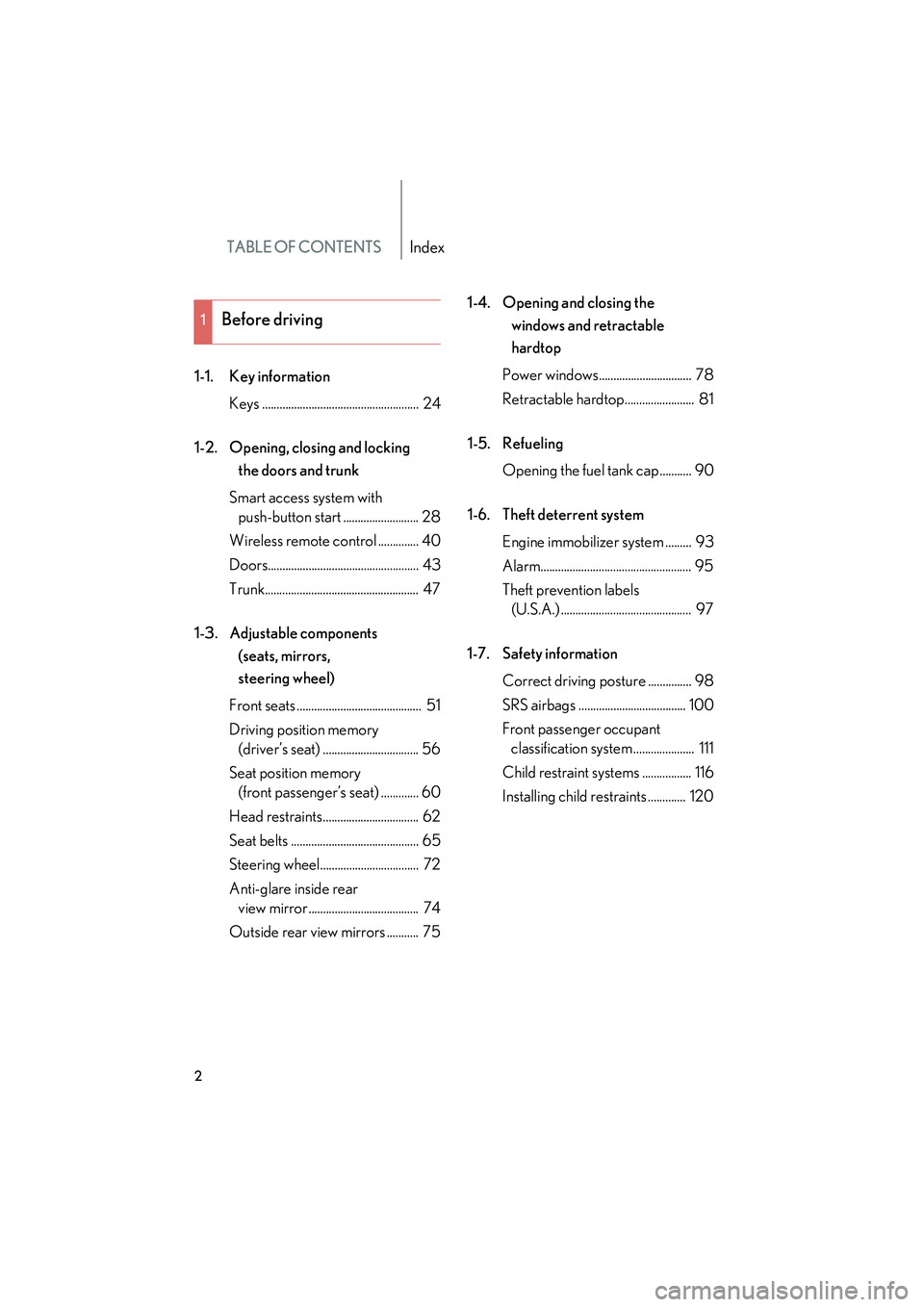
TABLE OF CONTENTSIndex
10_IS250C/350C_U
2
1-1. Key informationKeys ...................................................... 24
1-2. Opening, closing and locking the doors and trunk
Smart access system with push-button start .......................... 28
Wireless remote control .............. 40
Doors.................................................... 43
Trunk..................................................... 47
1-3. Adjustable components (seats, mirrors,
steering wheel)
Front seats ........................................... 51
Driving position memory (driver’s seat) ................................. 56
Seat position memory (front passenger’s seat) ............. 60
Head restraints................................. 62
Seat belts ............................................ 65
Steering wheel.................................. 72
Anti-glare inside rear view mirror...................................... 74
Outside rear view mirrors ........... 75 1-4. Opening and closing the
windows and retractable
hardtop
Power windows................................ 78
Retractable hardtop........................ 81
1-5. Refueling Opening the fuel tank cap........... 90
1-6. Theft deterrent system Engine immobilizer system ......... 93
Alarm.................................................... 95
Theft prevention labels (U.S.A.) ............................................. 97
1-7. Safety information Correct driving posture ............... 98
SRS airbags ..................................... 100
Front passenger occupant classification system ..................... 111
Child restraint systems ................. 116
Installing child restraints ............. 120
1Before driving
Page 24 of 586
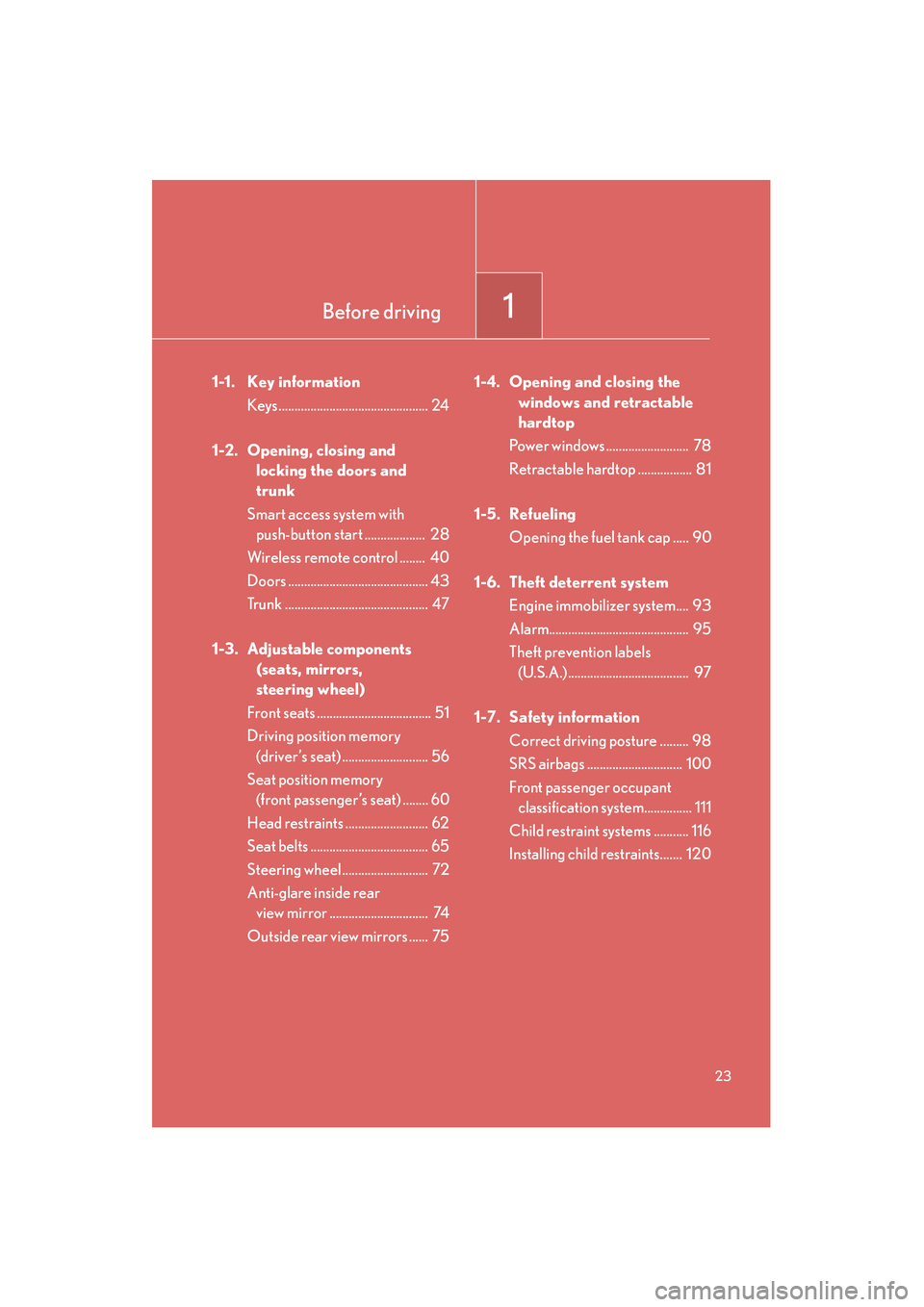
Before driving1
23
10_IS250C/350C_U
1-1. Key informationKeys ............................................... 24
1-2. Opening, closing and locking the doors and
trunk
Smart access system with push-button start ................... 28
Wireless remote control ........ 40
Doors ............................................ 43
Trunk ............................................. 47
1-3. Adjustable components (seats, mirrors,
steering wheel)
Front seats .................................... 51
Driving position memory (driver’s seat) ........................... 56
Seat position memory (front passenger’s seat) ........ 60
Head restraints .......................... 62
Seat belts ..................................... 65
Steering wheel........................... 72
Anti-glare inside rear view mirror ............................... 74
Outside rear view mirrors ...... 75 1-4. Opening and closing the
windows and retractable
hardtop
Power windows .......................... 78
Retractable hardtop ................. 81
1-5. Refueling Opening the fuel tank cap ..... 90
1-6. Theft deterrent system Engine immobilizer system.... 93
Alarm............................................ 95
Theft prevention labels (U.S.A.)...................................... 97
1-7. Safety information Correct driving posture ......... 98
SRS airbags .............................. 100
Front passenger occupant classification system............... 111
Child restraint systems ........... 116
Installing child restraints....... 120
Page 103 of 586
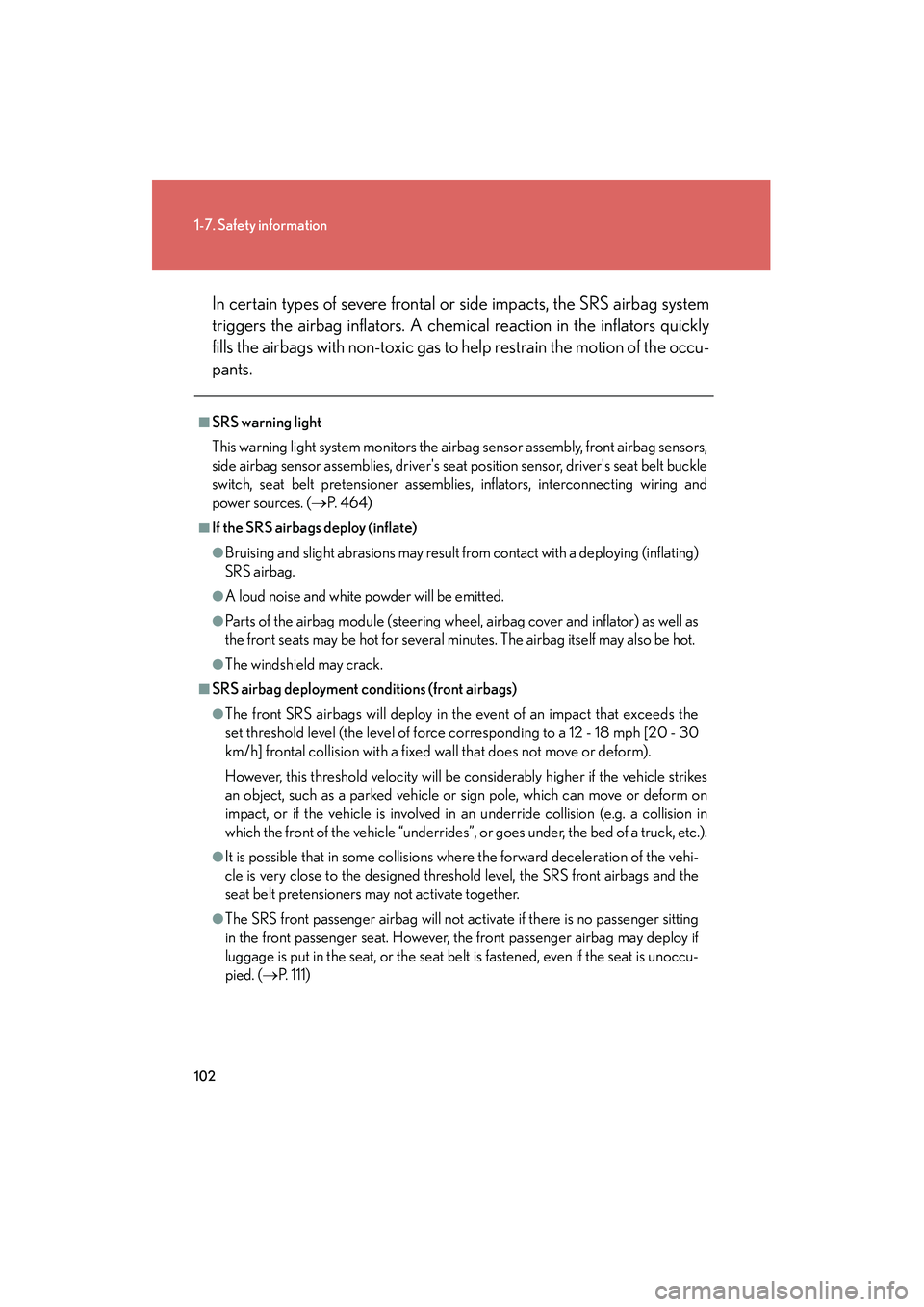
102
1-7. Safety information
10_IS250C/350C_UIn certain types of severe frontal or side impacts, the SRS airbag system
triggers the airbag inflators. A chem
ical reaction in the inflators quickly
fills the airbags with non-toxic gas to help restrain the motion of the occu-
pants.
■SRS warning light
This warning light system monitors the airbag sensor assembly, front airbag sensors,
side airbag sensor assemblies, driver's seat position sensor, driver's seat belt buckle
switch, seat belt pretensioner assemblies, inflators, interconnecting wiring and
power sources. ( →P. 4 6 4 )
■If the SRS airbags deploy (inflate)
●Bruising and slight abrasions may result from contact with a deploying (inflating)
SRS airbag.
●A loud noise and white powder will be emitted.
●Parts of the airbag module (steering wheel, airbag cover and inflator) as well as
the front seats may be hot for several minutes. The airbag itself may also be hot.
●The windshield may crack.
■SRS airbag deployment conditions (front airbags)
●The front SRS airbags will deploy in the event of an impact that exceeds the
set threshold level (the level of force corresponding to a 12 - 18 mph [20 - 30
km/h] frontal collision with a fixed wall that does not move or deform).
However, this threshold velocity will be considerably higher if the vehicle strikes
an object, such as a parked vehicle or sign pole, which can move or deform on
impact, or if the vehicle is involved in an underride collision (e.g. a collision in
which the front of the vehicle “underrides”, or goes under, the bed of a truck, etc.).
●It is possible that in some collisions where the forward deceleration of the vehi-
cle is very close to the designed threshold level, the SRS front airbags and the
seat belt pretensioners may not activate together.
●The SRS front passenger airbag will not activate if there is no passenger sitting
in the front passenger seat. However, the front passenger airbag may deploy if
luggage is put in the seat, or the seat belt is fastened, even if the seat is unoccu-
pied. ( →P. 111)
Page 137 of 586
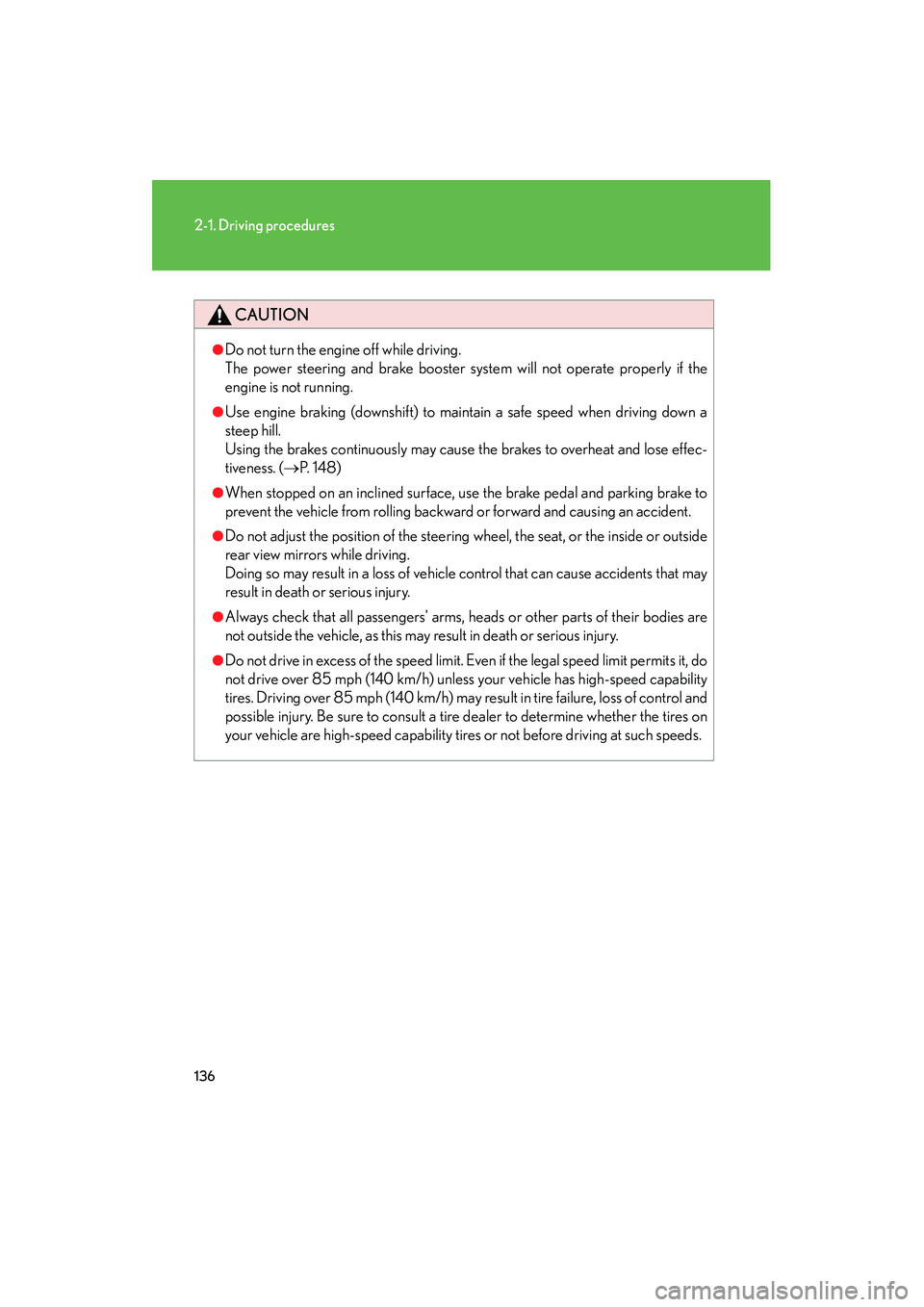
136
2-1. Driving procedures
10_IS250C/350C_U
CAUTION
●Do not turn the engine off while driving.
The power steering and brake booster system will not operate properly if the
engine is not running.
●Use engine braking (downshift) to maintain a safe speed when driving down a
steep hill.
Using the brakes continuously may cause the brakes to overheat and lose effec-
tiveness. (→P. 1 4 8 )
●When stopped on an inclined surface, use the brake pedal and parking brake to
prevent the vehicle from rolling backward or forward and causing an accident.
●Do not adjust the position of the steering wheel, the seat, or the inside or outside
rear view mirrors while driving.
Doing so may result in a loss of vehicle control that can cause accidents that may
result in death or serious injury.
●Always check that all passengers' arms, heads or other parts of their bodies are
not outside the vehicle, as this may result in death or serious injury.
●Do not drive in excess of the speed limit. Even if the legal speed limit permits it, do
not drive over 85 mph (140 km/h) unless your vehicle has high-speed capability
tires. Driving over 85 mph (140 km/h) may result in tire failure, loss of control and
possible injury. Be sure to consult a tire dealer to determine whether the tires on
your vehicle are high-speed capability tires or not before driving at such speeds.
Page 141 of 586

140
2-1. Driving procedures
10_IS250C/350C_U
NOTICE
■When driving the vehicleWith automatic transmission vehicles
●Do not use the accelerator pedal or depress the accelerator and brake pedals
together to hold the vehicle on a hill.With manual transmission vehicles
●Do not rest your foot on the clutch pedal while driving.
Doing so may cause clutch trouble.
●Do not use any gears other than the first gear when starting off and moving for-
ward.
Doing so may damage the clutch.
●Do not use the clutch to hold the vehicle when stopping on an uphill grade.
Doing so may damage the clutch.
■When parking the vehicle
With automatic transmission vehicles, always put the shift lever in P. Failure to do so
may cause the vehicle to move or the vehicle may accelerate suddenly if the accel-
erator pedal is accidentally depressed.
■Avoiding damage to vehicle parts
●Do not turn the steering wheel fully in either direction and hold it there for a long
time.
Doing so may damage the power steering motor.
●When driving over bumps in the road, drive as slowly as possible to avoid damag-
ing the wheels, underside of the vehicle, etc.
Page 142 of 586
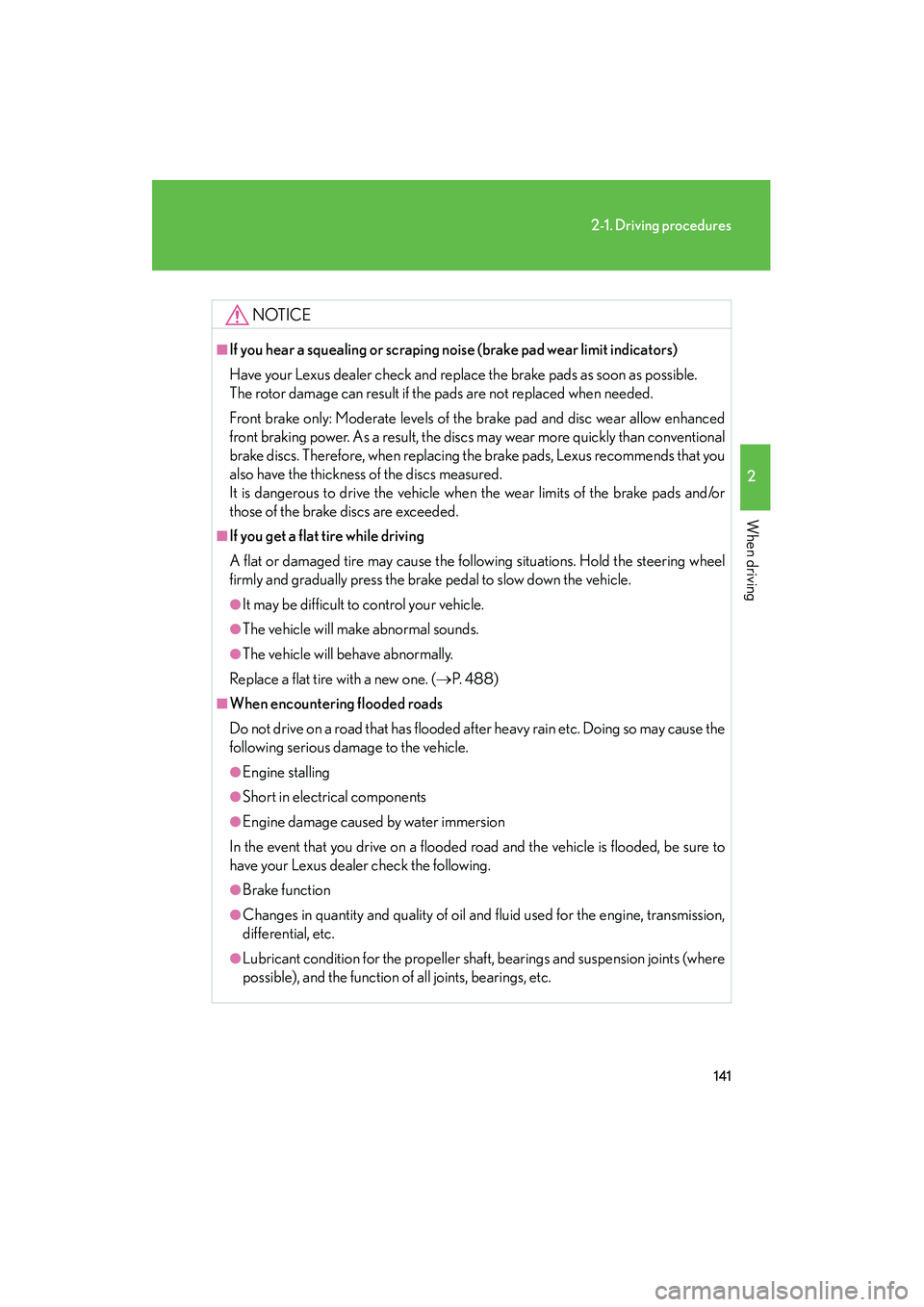
141
2-1. Driving procedures
2
When driving
10_IS250C/350C_U
NOTICE
■If you hear a squealing or scraping noise (brake pad wear limit indicators)
Have your Lexus dealer check and replace the brake pads as soon as possible.
The rotor damage can result if the pads are not replaced when needed.
Front brake only: Moderate levels of the brake pad and disc wear allow enhanced
front braking power. As a result, the discs may wear more quickly than conventional
brake discs. Therefore, when replacing the brake pads, Lexus recommends that you
also have the thickness of the discs measured.
It is dangerous to drive the vehicle when the wear limits of the brake pads and/or
those of the brake discs are exceeded.
■If you get a flat tire while driving
A flat or damaged tire may cause the following situations. Hold the steering wheel
firmly and gradually press the brake pedal to slow down the vehicle.
●It may be difficult to control your vehicle.
●The vehicle will make abnormal sounds.
●The vehicle will behave abnormally.
Replace a flat tire with a new one. ( →P. 4 8 8 )
■When encountering flooded roads
Do not drive on a road that has flooded after heavy rain etc. Doing so may cause the
following serious damage to the vehicle.
●Engine stalling
●Short in electrical components
●Engine damage caused by water immersion
In the event that you drive on a flooded road and the vehicle is flooded, be sure to
have your Lexus dealer check the following.
●Brake function
●Changes in quantity and quality of oil and fluid used for the engine, transmission,
differential, etc.
●Lubricant condition for the propeller shaft, bearings and suspension joints (where
possible), and the function of all joints, bearings, etc.
Page 146 of 586

145
2-1. Driving procedures
2
When driving
10_IS250C/350C_U
■If the engine does not start
The engine immobilizer system may not have been deactivated. (→P. 9 3 )
■When the steering lock cannot be released
■When the “ENGINE START STOP” switch indicator flashes in amber
The system may be malfunctioning. Have the vehicle inspected by your Lexus
dealer immediately.
■Auto power off function
If the vehicle is left in ACCESSORY mode for more than an hour with the shift lever
in P (vehicles with an automatic transmission), the “ENGINE START STOP” switch
will automatically turn OFF.
■Electronic key battery depletion
→P. 3 4
■When the electronic key battery is fully discharged
→P. 4 2 5
■Conditions affecting operation
→P. 3 2
■Note for the entry function
→P. 3 5 The “ENGINE START STOP” switch indica-
tor will flash in green and a message will be
shown on the multi-information display. Press
the “ENGINE START STOP” switch again
while turning the steering wheel left and right.
Page 205 of 586

204
2-4. Using other driving systems
10_IS250C/350C_U
Driving assist systems
To help enhance driving safety and performance, the following systems
operate automatically in response to various driving situations. Be aware,
however, that these systems are supplementary and should not be relied
upon too heavily when operating the vehicle.
■ ABS (Anti-lock Brake System)
Helps to prevent wheel lock when the brakes are applied suddenly, or if
the brakes are applied while driving on a slippery road surface.
■Brake assist
Generates an increased level of braking force after the brake pedal is
depressed, when the system detects a panic stop situation.
■VSC (Vehicle Stability Control)
Helps the driver to control skidding when swerving suddenly or turning on
slippery road surfaces.
■TRAC (Traction Control)
Maintains drive power and prevents the rear wheels from spinning when
starting the vehicle or accelerating on slippery roads.
■Hill-start assist control
→ P. 2 1 0
■EPS (Electric Power Steering)
Employs an electric motor to reduce the amount of effort needed to turn
the steering wheel.
Page 287 of 586
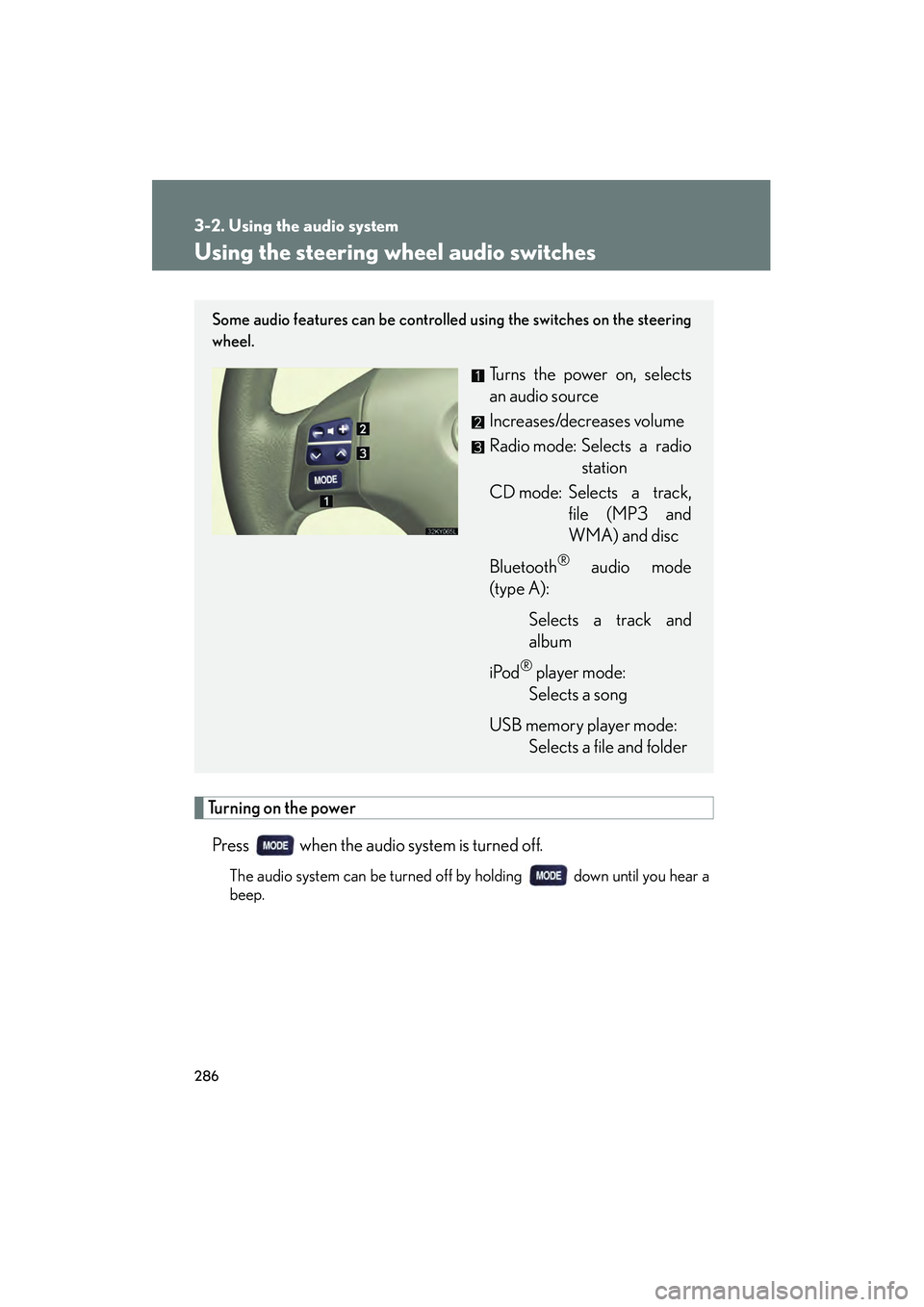
286
3-2. Using the audio system
10_IS250C/350C_U
Using the steering wheel audio switches
Turning on the powerPress when the audio system is turned off.
The audio system can be turned off by holding down until you hear a
beep.
Some audio features can be controlled using the switches on the steering
wheel.
Turns the power on, selects
an audio source
Increases/decreases volume
Radio mode: Selects a radio station
CD mode: Selects a track, file (MP3 and
WMA) and disc
Bluetooth
® audio mode
(type A):
Selects a track and
album
iPod
® player mode:
Selects a song
USB memory player mode: Selects a file and folder
Page 432 of 586

431
4-3. Do-it-yourself maintenance
4
Maintenance and care
10_IS250C/350C_U
Fuse layout and amperage ratings■ Engine compartment (type A fuse box)
FuseAmpereCircuit
1TURN-HAZ15 AEmergency flashers, turn signals
2IG2 MAIN20 AIG2, IGN, GAUGE
3RAD NO.230 AAudio
4D/C CUT20 ADOME, MPX-B
5RAD NO.130 AAudio
6MPX-B10 A
Headlights, front fog lights, parking
lights, license plate lights, windshield
washer, power windows, power seats,
electric tilt and telescopic steering
column, meter, smart access system
with push-button start, outside rear
view mirrors, air conditioning system,
retractable hardtop, clock
7DOME10 AInterior lights, meter, outer foot lights
8CDS10 APo w e r s o u rc e